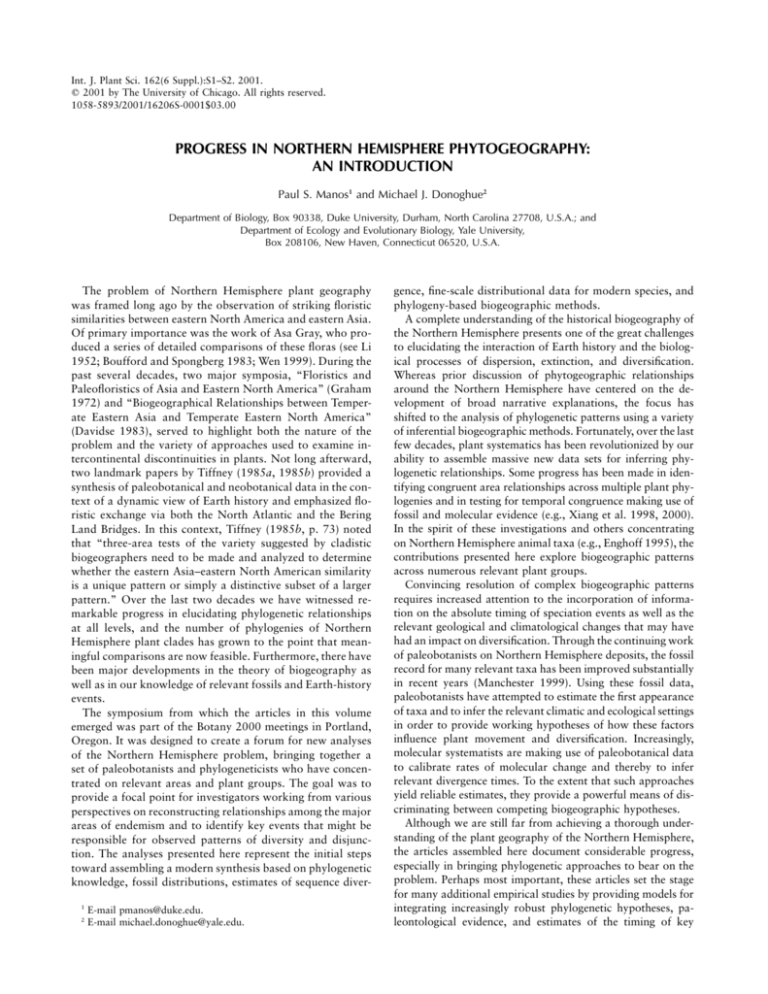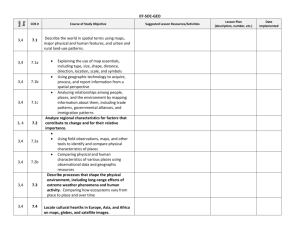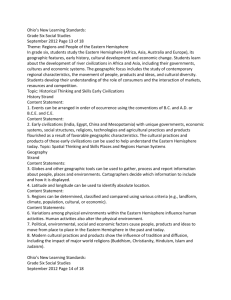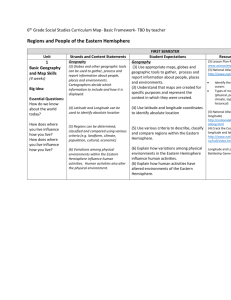
Int. J. Plant Sci. 162(6 Suppl.):S1–S2. 2001.
䉷 2001 by The University of Chicago. All rights reserved.
1058-5893/2001/16206S-0001$03.00
PROGRESS IN NORTHERN HEMISPHERE PHYTOGEOGRAPHY:
AN INTRODUCTION
Paul S. Manos1 and Michael J. Donoghue2
Department of Biology, Box 90338, Duke University, Durham, North Carolina 27708, U.S.A.; and
Department of Ecology and Evolutionary Biology, Yale University,
Box 208106, New Haven, Connecticut 06520, U.S.A.
The problem of Northern Hemisphere plant geography
was framed long ago by the observation of striking floristic
similarities between eastern North America and eastern Asia.
Of primary importance was the work of Asa Gray, who produced a series of detailed comparisons of these floras (see Li
1952; Boufford and Spongberg 1983; Wen 1999). During the
past several decades, two major symposia, “Floristics and
Paleofloristics of Asia and Eastern North America” (Graham
1972) and “Biogeographical Relationships between Temperate Eastern Asia and Temperate Eastern North America”
(Davidse 1983), served to highlight both the nature of the
problem and the variety of approaches used to examine intercontinental discontinuities in plants. Not long afterward,
two landmark papers by Tiffney (1985a, 1985b) provided a
synthesis of paleobotanical and neobotanical data in the context of a dynamic view of Earth history and emphasized floristic exchange via both the North Atlantic and the Bering
Land Bridges. In this context, Tiffney (1985b, p. 73) noted
that “three-area tests of the variety suggested by cladistic
biogeographers need to be made and analyzed to determine
whether the eastern Asia–eastern North American similarity
is a unique pattern or simply a distinctive subset of a larger
pattern.” Over the last two decades we have witnessed remarkable progress in elucidating phylogenetic relationships
at all levels, and the number of phylogenies of Northern
Hemisphere plant clades has grown to the point that meaningful comparisons are now feasible. Furthermore, there have
been major developments in the theory of biogeography as
well as in our knowledge of relevant fossils and Earth-history
events.
The symposium from which the articles in this volume
emerged was part of the Botany 2000 meetings in Portland,
Oregon. It was designed to create a forum for new analyses
of the Northern Hemisphere problem, bringing together a
set of paleobotanists and phylogeneticists who have concentrated on relevant areas and plant groups. The goal was to
provide a focal point for investigators working from various
perspectives on reconstructing relationships among the major
areas of endemism and to identify key events that might be
responsible for observed patterns of diversity and disjunction. The analyses presented here represent the initial steps
toward assembling a modern synthesis based on phylogenetic
knowledge, fossil distributions, estimates of sequence diver1
2
E-mail pmanos@duke.edu.
E-mail michael.donoghue@yale.edu.
gence, fine-scale distributional data for modern species, and
phylogeny-based biogeographic methods.
A complete understanding of the historical biogeography of
the Northern Hemisphere presents one of the great challenges
to elucidating the interaction of Earth history and the biological processes of dispersion, extinction, and diversification.
Whereas prior discussion of phytogeographic relationships
around the Northern Hemisphere have centered on the development of broad narrative explanations, the focus has
shifted to the analysis of phylogenetic patterns using a variety
of inferential biogeographic methods. Fortunately, over the last
few decades, plant systematics has been revolutionized by our
ability to assemble massive new data sets for inferring phylogenetic relationships. Some progress has been made in identifying congruent area relationships across multiple plant phylogenies and in testing for temporal congruence making use of
fossil and molecular evidence (e.g., Xiang et al. 1998, 2000).
In the spirit of these investigations and others concentrating
on Northern Hemisphere animal taxa (e.g., Enghoff 1995), the
contributions presented here explore biogeographic patterns
across numerous relevant plant groups.
Convincing resolution of complex biogeographic patterns
requires increased attention to the incorporation of information on the absolute timing of speciation events as well as the
relevant geological and climatological changes that may have
had an impact on diversification. Through the continuing work
of paleobotanists on Northern Hemisphere deposits, the fossil
record for many relevant taxa has been improved substantially
in recent years (Manchester 1999). Using these fossil data,
paleobotanists have attempted to estimate the first appearance
of taxa and to infer the relevant climatic and ecological settings
in order to provide working hypotheses of how these factors
influence plant movement and diversification. Increasingly,
molecular systematists are making use of paleobotanical data
to calibrate rates of molecular change and thereby to infer
relevant divergence times. To the extent that such approaches
yield reliable estimates, they provide a powerful means of discriminating between competing biogeographic hypotheses.
Although we are still far from achieving a thorough understanding of the plant geography of the Northern Hemisphere,
the articles assembled here document considerable progress,
especially in bringing phylogenetic approaches to bear on the
problem. Perhaps most important, these articles set the stage
for many additional empirical studies by providing models for
integrating increasingly robust phylogenetic hypotheses, paleontological evidence, and estimates of the timing of key
S2
INTERNATIONAL JOURNAL OF PLANT SCIENCES
events. These studies will also fuel the development of the
theory and methods of historical biogeography necessary to
cope with a complexity of events so strikingly exemplified by
the Northern Hemisphere problem. Ultimately, we are confident that a detailed picture will emerge, which will in turn
have an impact on our understanding of the assembly, stability,
and change of plant communities through time. Such analyses
document monumental global changes in the past, and the
lessons learned may improve our ability to forecast such
changes and their consequences.
Acknowledgments
We thank the American Society of Plant Taxonomists and
the Botanical Society of American for supporting the symposium and for defraying the registration fees of the participants.
We are grateful to two editors of IJPS, Peter Crane and Ned
Friedman, for inviting us to contribute our papers to this special supplement. Finally, we extend special thanks to Fred Ruddat and Dennis Keppeler for their patience and expert editorial
assistance.
Literature Cited
Boufford DE, SA Spongberg 1983 Eastern Asian–Eastern North American phytogeographical relationships: a history from the time of Linnaeus to the twentieth century. Ann Mo Bot Gard 70:423–439.
Davidse G 1983 Biogeographical relationships between temperate eastern Asia and temperate eastern North America: the Twenty-Ninth
Annual Systematics Symposium. Ann Mo Bot Gard 70:421–422.
Enghoff H 1995 Historical biogeography of the Holarctic: area relationships, ancestral areas and dispersal of non-marine animals.
Cladistics 11:223–263.
Graham A 1972 Outline of the origin and historical recognition of
floristic affinities between Asia and eastern North America. Pages
1–18 in A Graham, ed. Floristics and paleofloristics of Asia and
eastern North America. Elsevier, Amsterdam.
Li H-L 1952 Floristic relationships between eastern Asia and eastern
North America. Trans Am Philos Soc 42:371–429.
Manchester SR 1999 Biogeographical relationships of North American Tertiary floras. Ann Mo Bot Gard 86:472–522.
Tiffney BH 1985a The Eocene North Atlantic Land Bridge: its importance in Tertiary and modern phytogeography of the Northern
Hemisphere. J Arnold Arbor Harvard Univ 66:243–273.
——— 1985b Perspectives on the origin of the floristic similarity between eastern Asia and eastern North America. J Arnold Arbor
Harvard Univ 66:73–94.
Wen J 1999 Evolution of eastern Asian and eastern North American
disjunct distributions in flowering plants. Annu Rev Ecol Syst 30:
421–455.
Xiang QY, DE Soltis, PS Soltis 1998 The eastern Asian and eastern
and western North American floristic disjunction: congruent phylogenetic patterns in seven diverse genera. Mol Phylogenet Evol 10:
178–190.
Xiang QY, DE Soltis, PS Soltis, SR Manchester, DJ Crawford 2000
Timing the eastern Asian–eastern North American floristic disjunction: molecular clock corroborates paleontological estimates. Mol
Phylogenet Evol 15:462–472.









